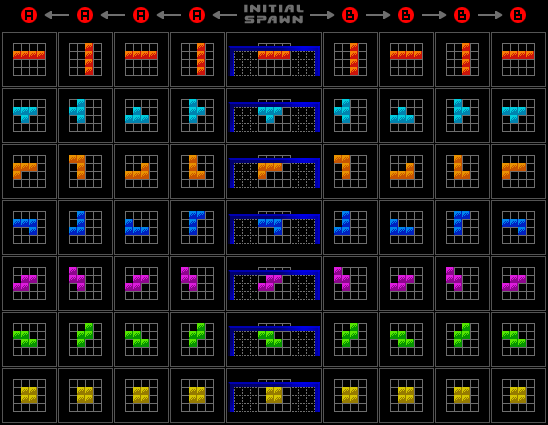Arika Rotation System
Arika Rotation System (also known as ARS) is a gameplay mechanic used in the Tetris: The Grand Master series and Tetris with Cardcaptor Sakura Eternal Heart, and is derived from Sega's rotation system. Many fan games also implement this rotation system.
Games using Arika Rotation System generally use IRS, fast DAS, lock delay, and firm drop, and tetrominoes start out with the topmost block on the top row (generally row 20). The "ARS" and "ARS2" modes of Tetris The Grand Master Ace use a hybrid of TGM rules and Guideline rules.
Basic rotation
The basic rotations inherits their properties from Sega rotation, which was used in many other Japanese Tetris games. Some defining characteristics include:
- Having 2 (as opposed to 4) rotation states for S, Z, and I tetrominoes.
- Keeping tetrominoes at an even level while rotating to always allow rotation when the tetromino is on a flat surface (except for the I tetromino - see exceptions below).
- Pointing the initial state of the T, L, and J tetrominoes downward.

Wall kicks
Up to 3 locations are tried, in this order, before rotation will fail:
- Basic rotation
- 1 space right of basic rotation
- 1 space left of basic rotation
In addition to these rules, there are some extra exceptions where certain wall kicks are not allowed:
- The I tetromino will never kick.
- L, J, and T tetrominoes, from their 3-wide orientations, will not kick off their center column. In the situations illustrated below if the
 marked block is occupied.
marked block is occupied.
|
| ||
|
| ||
|
However, there are very similar situations where additional off-center blocks will enable a wall kick, due to a bug in the way blocks that block a rotation are detected. In the situations illustrated below, the upper ![]() blocks are off-center and enable the kick even in the presence of
blocks are off-center and enable the kick even in the presence of ![]() blocks in the center column.
blocks in the center column.
Clockwise rotation will successfully kick:
|
Counter-clockwise rotation will successfully kick:
|
Wall kicks added in Tetris The Grand Master 3 Terror-Instinct
I-piece wall kicks
In Terror-Instinct, the I-pieces can kick walls and the stack. There are two different wall kicks.
Try to rotate |
Basic rotation fails |
Kick 2 space right | |||
Try to rotate |
Basic rotation fails |
Kick left |
Similarly to floor kicks, the I-piece needs to be touching part of the stack to kick one cell to the right.
Try to rotate |
Basic rotation fails |
No rotation occurs | |||
Try to rotate |
Basic rotation fails |
Kick right |
I tetromino's floor kicks
The I tetromino can kick the floor, but it can be performed only once and cannot kick the floor in mid-air.
Fail |
OK |
OK |
There are 2 different types of floor kicks.
Try to rotate |
Basic rotation fails |
Kick 1 space up | |||
Try to rotate |
Basic rotation fails |
Kick 2 space up |
T tetromino's floor kicks
The T tetromino can escape from a hollow, up to two times.
Try to rotate |
Basic rotation fails |
Kick up |
Rotating a T or I tetromino after it has floor kicked will permanently set the lock delay for that tetromino to zero. This is actually what prevents the second I floorkick. After the second rotation is processed, movement gets processed, allowing a shift of one cell left or right if it's done fast enough. Gravity is then applied. If the I tetromino is not in contact with an occupied cell below after processing gravity, any attempt to floorkick will fail, as explained above. If contact does exist, the tetromino will instantly lock down, preventing rotation from being processed at all.
The T tetromino has no such restriction, so it IS possible to make it floor kick twice, but it will lock after the second one because there is no way to process rotation again before it locks.
Right side bias
In TGM's rotation system, the Tetrominoes rotate on only one axis resulting in asymmetrical rotations. In this example, the I piece can't rotate on the left side of the stack;
|
|
A situation which would work on the right side.
Notice the I has 1 rotation axis;
|
|
I piece's rotation axis
This case does not apply to the T tetromino, as it rotates on its center;
|
|
T rotation axis
Mihara's conspiracy
Due to the right side bias with wall kicks, doing this move with a J when there is an empty hole right of the block that the J is caught on will lead to a hole.
L works:
Firm drop |
Rotate left |
Kicks to here |
J in the other hand, does not.
Firm drop |
Rotate right |
Kicks to here |
A block (marked as red) is required for the piece to do so.
Firm drop |
Rotate right |
This fails too |
Kicks to here |
ACE-ARS and ARS2
Ace's rotation is a hybrid of SRS and ARS. Ace features guideline colors and lock delay is now directly reset by rotation/movement. A maximum of 128 lock delay resets are permitted per piece. Piece spawns that would previously have resulted in death (blocks occupying row 19/20 spawn locations) will now instead cause the piece to spawn higher, to a maximum of rows 21/22. This effectively makes the usable well size 2 rows higher.
ARS2 is available through an Xbox live patch for the game. Normal ARS features Sonic Lock (locking hard drop) and non-locking soft drop. ARS2 reverts these drop mechanics to how it worked in TGM3 and TGM2.
See also
- Sega Rotation
- Tetris Plus 2: The first game to use wall kicks with a Sega-like rotation system.
References
| |||||||||||||||||